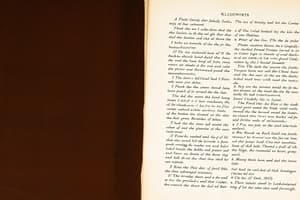Podcast
Questions and Answers
What is the total number of page breaks in the content?
What is the total number of page breaks in the content?
- 31
- 33 (correct)
- 10
- 24
What is the most likely purpose of this document based on the content?
What is the most likely purpose of this document based on the content?
- A table of contents for a book
- An outline of a presentation
- A list of page numbers for a book
- An empty document for a specific project (correct)
Which of these could NOT be used to represent the content?
Which of these could NOT be used to represent the content?
- A document with placeholder images
- A document with empty paragraphs
- A document with a table of contents (correct)
- A blank document
How many page numbers are explicitly mentioned in the content?
How many page numbers are explicitly mentioned in the content?
If you are working with this document, what is the most important task you likely need to do?
If you are working with this document, what is the most important task you likely need to do?
Flashcards are hidden until you start studying
Study Notes
Introduction to Computer Networking
-
A note on the use of slides: Slides are freely available for faculty, students, and readers. They are in PowerPoint form and can be modified and adapted to individual needs. They should be cited properly.
-
Computer Networking (A Top Down Approach, 6th edition): Authored by Jim Kurose and Keith Ross, published by Addison-Wesley in March 2012.
Roadmap for Chapter 1
- 1.1 What is the Internet?
- 1.2 Network Edge: End systems, access networks, links.
- 1.3 Network Core: Packet switching, circuit switching, network structure.
- 1.4 Delay, Loss, Throughput in Networks: How networks handle transmission, data loss, and rates.
- 1.5 Protocol Layers, Service Models: How different layers communicate and provide services.
- 1.6 Networks Under Attack: Security: Threats and vulnerabilities.
- 1.7 History: Background of the internet.
"Nuts and Bolts" View of the Internet
- Millions of connected computing devices (hosts/end systems).
- End systems running network applications.
- Communication links (fiber, copper, radio, satellite).
- Transmission rate (bandwidth).
- Packet switches (routers and switches) forward packets (chunks of data).
"Network of Networks" View of the Internet
- Internet as interconnected internet service providers (ISPs).
- Protocols control message sending and receiving (e.g., TCP, IP, HTTP, Skype, 802.11).
- Internet Standards documented in RFCs (requests for comments).
- IETF (Internet Engineering Task Force) defines and maintains these standards.
Internet as a Service View
- Infrastructure that serves applications like Web, VoIP, email.
- Programming interfaces for applications.
- Service options similar to postal service.
What is a Protocol?
- Protocols define message format, order of communications.
- Govern communication between network entities (machines).
- Controls the actions taken during transmission.
Access Networks and Physical Media
- Connecting end systems to edge routers.
- Residential, institutional, and mobile access networks.
- Physical media type and bandwidth (shared or dedicated).
Examples of Access Networks
- DSL (Digital Subscriber Line): Uses existing phone lines to transmit data and voice, with varied upstream and downstream transmission rates.
- Cable Network: Uses cable TV infrastructure to transmit data. Uses frequency division multiplexing (FDM).
- Hybrid Fiber Coax (HFC): Combines fiber optic and coaxial cable technologies for high-speed data transmission.
- Wireless LANs: Internal to buildings via wireless access points.
- Wide-area Wireless Access: Mobile cellular networks (3G, 4G, LTE) extending over broader areas.
- Enterprise Access (Ethernet): Used in companies and university networks, using switches for connection.
How Loss and Delay Occur
- Packet queues in router buffers.
- Packet arrival rate exceeding output link capacity.
- Packets queue up, waiting their turn to be transmitted which causes delay.
Four Sources of Packet Delay
- Transmission: L/R (bits/packet length divided by link bandwidth).
- Propagation: d/s (distance divided by propagation speed).
- Nodal Processing: Checking bits, determining output link.
- Queueing: Waiting in buffer for transmission.
Caravan Analogy
- Illustrates packet propagation delays and queues.
Queueing Delay (Revisited)
- Average delay influenced by traffic intensity (La/R).
- Relationship with traffic intensity and average queueing delay, small for La/R approaching 0. Large for La/R as it approaches 1 and becomes infinite when La/R is greater than 1.
"Real" Internet Delays and Routes
- Traceroute program measures delay.
- Routes packets through intermediate routers.
Packet Loss
- Queueing buffering preceding a link has finite capacity.
- Packets arriving at a full queue are dropped.
- Lost packets may need retransmission.
Throughput
- Rate at which bits are transferred between sender and receiver.
- Instantaneous and average throughput rates.
- Bottleneck link constrains end-end throughput.
- Per-connection end-end throughput affected by limited bandwidth or contention with other connections.
Studying That Suits You
Use AI to generate personalized quizzes and flashcards to suit your learning preferences.




